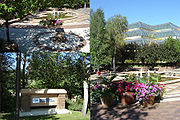
Saskatchewan Research Council
Encyclopedia

History
The Province of SaskatchewanSaskatchewan
Saskatchewan is a prairie province in Canada, which has an area of . Saskatchewan is bordered on the west by Alberta, on the north by the Northwest Territories, on the east by Manitoba, and on the south by the U.S. states of Montana and North Dakota....
established SRC in 1947. SRC carried out its work through grants-in-aid to specific applied research activities at the University of Saskatchewan
University of Saskatchewan
The University of Saskatchewan is a Canadian public research university, founded in 1907, and located on the east side of the South Saskatchewan River in Saskatoon, Saskatchewan, Canada. An "Act to establish and incorporate a University for the Province of Saskatchewan" was passed by the...
. SRC’s first Director of Research was Dr. T. T. Thorvaldson, head of the university’s chemistry department.
In 1954, SRC expanded its mandate to incorporate independent research. Dr. T.E. Warren, director of the Fuels Research Laboratory in Ottawa, was appointed to oversee the construction of a new building and hire employees. Under Warren’s direction, SRC opened its own laboratories in 1958 and then expanded in 1963.
With newly appointed SRC President Dr. T.P. Pepper leading, in 1972 SRC changed its structure, then based on academic disciplines, to one based on industry sectors. By 1973, SRC was earning more money from research contracts than it received from the provincial government.
In 1983, J.P. Hutch, a former Deputy Minister of Industry and private sector engineering executive, became SRC’s president. Hutch guided SRC as it took over operating the heavy oil lab in Regina from Saskatchewan Energy and Mines.
SRC has grown to 370 employees and $41 million in annual revenues. Its five divisions—Agriculture, Biotechnology and Food; Alternative Energy and Manufacturing; Energy; Environment and Forestry; Mining and Minerals—provide applied research and development services.
Research
Since its inception, SRC has published 2,600 research reports that are available to the public. It has produced another 2,700 confidential research reports for clients.SRC’s research history includes developing a residential energy conservation research report that was used in the National Building Code of Canada
National Building Code of Canada
The National Building Code of Canada is the model building code of Canada. It is issued by the Institute for Research In Construction ], a part of the National Research Council of Canada...
. SRC also mapped the groundwater resources in Saskatchewan south of the Precambrian Shield. Its scientists evaluated Saskatchewan’s extensive lignite
Lignite
Lignite, often referred to as brown coal, or Rosebud coal by Northern Pacific Railroad,is a soft brown fuel with characteristics that put it somewhere between coal and peat...
(coal) resources. SRC’s GenServe Laboratories were involved in testing for bovine spongiform encephalopathy (Mad Cow disease). SRC is also known for building the Factor 9 home, which uses 90 per cent less energy and 50 per cent less water than a similar home built during the 1970s.
Current research is conducted in a range of laboratories and test facilities. SRC’s environmental analytical laboratories provide environmental monitoring and other tests to clients. They house a SLOWPOKE
Slowpoke
Slowpoke may refer to:*Slowpoke , a fictional species of creatures in Pokémon media*SLOWPOKE reactor, a nuclear research reactor*Slowpoke , a band from Dallas, Texas, who have worked with the Toadies*Slowpoke...
-II nuclear research reactor that performs analytical tests. Its geoanalytical lab provides geochemical analyses for the mineral exploration industry. SRC’s GenServe Laboratories carry out DNA
DNA
Deoxyribonucleic acid is a nucleic acid that contains the genetic instructions used in the development and functioning of all known living organisms . The DNA segments that carry this genetic information are called genes, but other DNA sequences have structural purposes, or are involved in...
-based testing for plants, cattle and other livestock. Its other labs include Petroleum Analytical Laboratories, an Outdoor Testing Facility, a Biofuels Test Centre, a Fermentation Pilot Plant, a Pipe Flow Technology Centre, a 3D Virtual Reality Centre, a diamond testing facility and a natural gas vehicles facility.

